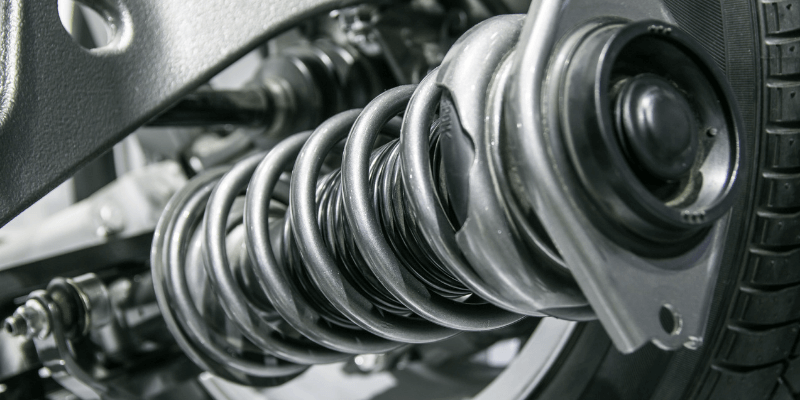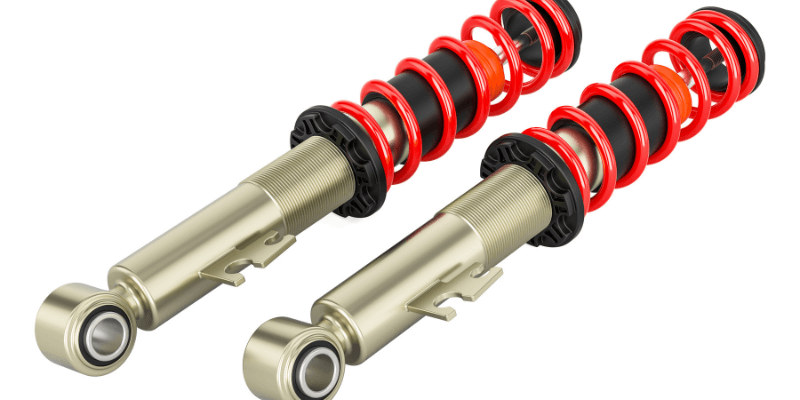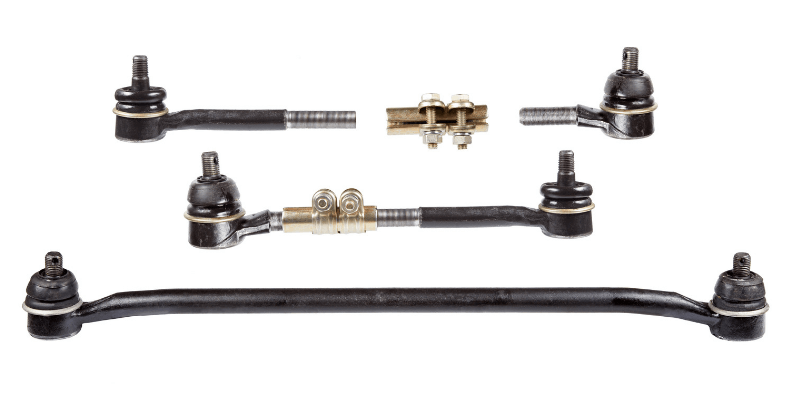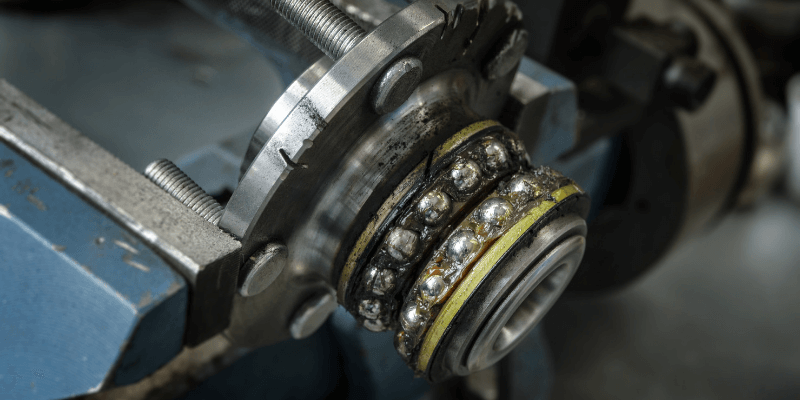 Swipe for more categories
Swipe for more categories 
Car Suspension Parts and Repair
Warning: Undefined variable $post_id in /var/www/dsw/wp-content/themes/DriveSmart_2024_v1.1/single.php on line 27
May 10, 2019
Warning: Undefined variable $post_id in /var/www/dsw/wp-content/themes/DriveSmart_2024_v1.1/single.php on line 75
Car Suspension Parts and Repair
Warning: Undefined variable $post_id in /var/www/dsw/wp-content/themes/DriveSmart_2024_v1.1/single.php on line 76
May 10, 2019
The suspension in a car is the first line of defense against potholes, speed bumps, and road debris. Although a car’s suspension is sophisticated, problems still occur. The more you know about your vehicle’s suspension, the better equipped you’ll be in managing and avoiding problems as they arise.
What is Car Suspension?
Car suspension is a system that enables a vehicle to drive smoothly while holding the road to maximize ride quality. If a car’s engine is performing well, but the driver cannot control the vehicle, said engine never gets the opportunity to output any power. Ensuring that the vehicle’s tires stay in contact with the road while creating productive friction is what the auto suspension is designed for.
The handling of a vehicle is its ability to maneuver, accelerate, and brake safely. The suspension also cradles the passenger compartment to spare those within the car from feeling every bump in the road. There are a few different types of suspension systems for cars and trucks. It may be helpful to know what kind of suspension a car has. The main components to an auto suspension system are the tires, springs, and dampers.
Car Suspension Parts
Springs

The springs in a suspension system are what hold the weight of the vehicle over the tires and the road. Over time, these springs can begin to droop or snap and will need to be replaced. There are four types of spring systems used in car suspension. These are:
- Coil Springs: These are the type of springs most are familiar with. A coil spring is a coiled bar that expands and compresses to absorb motion energy.
- Leaf Springs: A leaf spring is a series of metal bars bound together with loops on the ends. The loops are connected to the chassis while the axle rests on the center of the spring. These types of springs are generally used for trucks and larger/heavier vehicles.
- Torsion Bars: This is a metal bar attached to the chassis with a torsion key mounted perpendicular to the bar. The torsion key creates a lever that provides resistance to a wheel’s vertical motion.
- Air Springs: Air springs use compressed air in a cylindrical compartment to absorb shaking and vertical motion in a vehicle’s wheels.
Modern car suspension systems mostly use coil springs. The replacement of coil springs average cost is between $300 and $400.
Wheels go through vertical acceleration when they go over a bump or come in contact with a hole in the road. Without a proper spring system, the wheels would hit a bump or hole and this would cause the tires to lift away from the road’s surface.
When a car’s wheels leave the road, the driver has no control over the car. Springs absorb the vertical acceleration energy, but they have no way to disperse this energy. Dampers are required for this purpose.
Dampers
A Damper is a component in the suspension system that pulls kinetic energy produced by the springs and converts it. Without a dampening device, a spring will compress and extend in reaction to uneven road contact naturally. This means that the spring is uninhibited and will bounce and stretch freely until the kinetic energy has been used. In such a situation, a vehicle would be uncontrollably bouncing and shaking with every bump its tires encounter.
Shock Absorbers

A shock absorber is a dampening device that sits between a wheel axle and the car’s frame. When the springs oscillate, the shocks take the unwanted energy from the springs and convert it into pressure internally. The shocks are full of fluid that is pressed through the valves contained within when springs compress or extend. The piston inside has tiny holes that allow the hydraulic fluid to be pushed through very slowly. Slowing the piston slows the spring activity and stabilizes the vehicle.
Struts
Struts are like shock absorbers except they are mounted within a coil spring. A car strut serves as a dampening device and also offers structural support for the suspension system.
Replacing shocks and struts typically cost around $1,500 for a full set. Replacing a shock or strut individually can cost between $25 and $350. This varies based on the type of vehicle and the quality of the parts being purchased.
Stabilizer Bars
Also known as anti-sway or anti-roll bars, Stabilizer Bars are mainly put in place to keep a vehicle from rolling over during sharp turns. The bar itself is a metal rod running the full length of the drive axle; connecting the left and right wheels. When a wheel experiences vertical movement, the stabilizer bar transfers the motion to the opposing wheel which levels the vehicle out. Not all vehicles come with anti-sway bars, but they can be installed easily. To Replace or install an anti-sway bar will cost roughly $100 for the actual part, and about $60 for the labor costs.
Shocks vs. Struts
Shocks and struts are similar components to your vehicle’s suspension. However, they do not perform in the same way. Shocks absorb the energy from the springs that cushion the vertical motion from the wheel to the car’s frame. Struts perform the same duty while they also support the weight of the vehicle; rather than simply dictating the distribution of weight as shocks do.
When shocks and struts wear down, it causes an overabundance of vehicle weight transfer. This means tires will not grip the road properly, and will negatively affect handling and braking.
Tie Rod and Tie Rod Ends

A tie rod is an important part of the steering mechanism in any vehicle. It consists of an inner tie rod end and an outer tie rod end. The outer tie rod end enables the tie rod length to be adjusted. This adjustment is necessary to set the wheel alignment. The tie rod ends wear regularly and can negatively affect the suspension system. When tie rod ends wear, they will get loose and impact the steering and handling of a vehicle. If a bad tie rod end isn’t replaced quickly, it will be detrimental to the front end alignment and cause front end suspension issues.
If a vehicle pulls to the left or right while driving, this could be a problem with a tie rod end. If the vehicle is shaking, vibrating, or experiencing loose and unresponsive steering, these are also bad tie rod symptoms. If a tie rod ceases to function completely, the driver will lose total control of the vehicle. The cost to replace a bad tie rod is between $70 and $200.
Wheel Bearing
The Wheel Bearing is a crucial component of the proper operation of the wheels. A wheel bearing system is a series of steel balls rolling independently within a metal ring inside the wheel hub. The hub is on the end of the axle shaft and holds the lug bolts needed to bolt the tire onto the vehicle. Wheel bearings enable the wheels and tires to rotate smoothly; with speed and minimal friction.

Grinding noises in the wheel are the most obvious sign of a bad wheel bearing. Pay close attention to wheel bearing noise, especially if the noise gets louder as the vehicle accelerates. Wheel bearing replacement is not too common; the bearings should last for quite some time. However, it is important to have the problem dealt with quickly, as issues with the wheel bearing can be a serious safety concern. If a vehicle is pulling (veering left or right), this can mean the wheel bearings have been compromised. To replace a wheel bearing, the cost is usually between $300 and $430.
Ball Joint and Spindle
The suspension system needs to move with the road beneath it. Without ball joints, the control arms connected to the spindle would have no pivot point from which to move. The Spindle is connected to the upper and lower control arms and is the center point around which the wheel and rotor revolve. Ball joints and tie rod ends both allow the wheels to direct the vehicle while moving up and down with the road. Bad ball joint symptoms can be inconsistent steering and clunking sounds when driving over bumps in the road; as well as squeaking or creaking noises when turning. The replacement cost of a ball joint on a vehicle will vary with the model of the vehicle; putting the price bracket between $200 and $1,000.
Car Suspension Problems
A vehicle’s suspension takes a lot of abuse. Driving on a bad road, or driving erratically will cause wear to the suspension system. Such wear is unavoidable, but recognizing symptoms of car suspension problems ensures that a driver can stay ahead of catastrophe. Below are some of the tell-tale signs of a suspension issue:
- Vehicle Pulling: If the car is veering to the left or right on its own while driving, this can be a sign of a suspension issue, a wheel alignment issue, or a tire tread wear problem.
- Vehicle Sags at a Specific Corner: When this is observed, the case is usually a problem with the suspension concerning a particular component beneath the sagging portion of the vehicle. This makes the problem easier to spot. It’s best to check the tire under the drooping point in the car to ensure it’s properly inflated.
- Front End Dips When Braking: Because most vehicles have the engine stored at the front end, this makes the front end heavier. If the shocks or struts at the front end of the vehicle are wearing out, they will be less capable of sustaining the wait.
- Shocks are Greasy or Oily: If shocks or struts are greasy, they are probably leaking the fluid they require to function properly. In this instance, they will need to be replaced.
- Vehicle Bounces Excessively: If a vehicle continues to bounce after driving over a bump or pothole in the road, this is a clear indicator of a suspension issue. The culprit, in this case, is usually worn shocks or a damaged leaf spring beneath the vehicle.
Car Suspension Repair
When it comes to suspension repair, many of the components must be replaced rather than repaired. The positive aspect of this would be cutting down labor costs. Working on a malfunctioning part takes more time than simply replacing it. Some common suspension parts that usually need to be replaced would be:
- Control Arms: These are the hinges that hold the wheels to the frame. Control arms also connect the wheels to the steering mechanism. If a control arm is bent and needs to be replaced, the cost is usually between $115 and $315.
- Bushings: Bushings are rubber and/or metal pieces that connect parts like tie rods and control arms to the their corresponding components. When they wear out, a vehicle will have handling issues and the tires will wear more quickly. Replacement of bushings can cost from $250 to $425 after labor cost is applied.
- Wheel Alignment: Wheel alignment is affected by suspension and vice versa. Pot holes and large road debris will knock wheels out of alignment and they will need to be reset. A two wheel alignment will cost between $50 and $75, while a full four wheel alignment will run between $100 and $150.
Why Car Suspension Repair is Important
When someone is driving a vehicle, the most important concern is obviously safety. A healthy suspension system enables the driver to operate the vehicle confidently because it’s main purpose is to keep the vehicle on the road. Routine inspections to the suspension will confirm that the tires will stay in contact with the road beneath them, and that the vehicle will steer properly and predictably.
Any signs of suspension issues should be investigated by a professional to avoid unwanted and potentially dangerous performance problems with a vehicle. Drivesmart’s Elite plan covers a vehicle’s full suspension system. Repairing or replacing things like bushings, bearings, ball joints, spindles, torsion bars, and more can be simple; with little or no cost to you with Drivesmart’s Elite coverage.
"> /var/www/dsw/wp-content/themes/DriveSmart_2024_v1.1/single.php on line 177
">
"> /var/www/dsw/wp-content/themes/DriveSmart_2024_v1.1/includes/quote-modal.php on line 8
">


